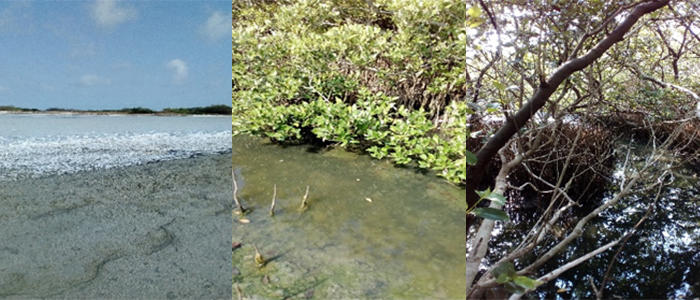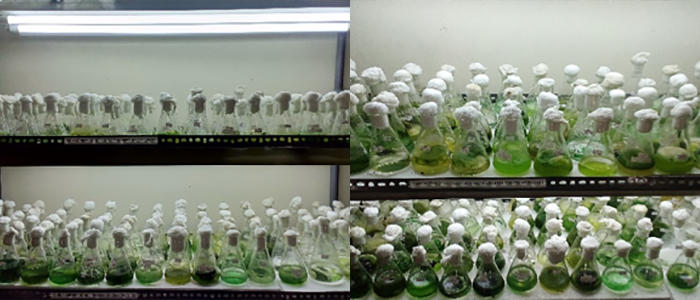Could cyanobacteria be a promising solution for global issues?
Posted on June 19, 2019 by Tharangika Bowange
The Early Career Microbiologists’ (ECM) Forum Summer Conference is dedicated to showcasing early career research, career development and networking. Tharangika Bowange is a postgraduate student from the National Institute of Fundamental Studies (NIFS), Sri Lanka and will be presenting her research into the commercial potential of cyanobacteria at the conference.
The surface of ponds and lakes are often covered with a green or blue-green film, but what is this blue-green film? Is it an organism? Is it beneficial to natural ecosystems? Is it just as ecologically and economically beneficial as plants? The answer is yes, these films are an ancient group of organisms called ‘cyanobacteria’ or ‘blue-green algae’. Similar to plants, they have chloroplasts, making them efficient photosynthesisers. The pigments in the chloroplasts give them their blue-green colour. These organisms have incredibly high morphological and functional diversity, universal distribution and many applications.
I am at the initial stage of my research work into cyanobacteria in Sri Lanka. Cyanobacteria can be found in ponds, lakes, marine water, salt marshes, mangroves, villu, hot springs, well water, paddy water and any water source you can imagine. They can also be found in soil, on rocks or any other surface where they can get their growth requirements. Their great ability to survive under extreme conditions such as high heat, cold and salinity has made them one of the most adaptive and diverse groups of organisms on Earth.
Sri Lanka is an island rich with a remarkably high diversity of flora and fauna. This higher ecological diversity is reflected in the richness of cyanobacteria in Sri Lanka. However, we still know very little about these organisms and their ecological and economic potential.
During my research, it was discovered that cyanobacteria are especially capable of adapting to changing extreme environmental conditions. These adaptations vary between individuals, and so groups of cyanobacteria can be highly diverse, showing morphological, biochemical and physiological differences within the group. Therefore, the identification of this group based on morphology is very complicated. So, my first objective is to collect different water samples representing different ecosystems in Sri Lanka, isolation of cyanobacteria in the water samples and temporary identification based on their morphology. I will also use molecular techniques to confirm their identification at a later date, and so can evaluate the presence of species in different ecosystems, and their evolutionary and ecological relationships.

Evaluation of cyanobacteria diversity in Sri Lanka, followed by the establishment of a cyanobacteria-specific culture collection will make a significant impact on conservation. Culture collections are preserved genetic resource centres, and preserve already isolated and identified species for academic and industrial purposes and future reference. We have already established a culture collection with over 100 isolated monocultures at NIFS which will be expanded in to a larger reference collection, representing the majority of Sri Lankan cyanobacteria, at the end of this study.

Some cyanobacteria species are well known to be important commercial products. For example, Spirulina sp. has a high nutrient content (especially protein and vitamins) and is used as a food source in many countries. It is also commercially available within cosmetic products. A previous study conducted in the Bioenergy and Soil Ecosystems research project at NIFS has identified some potential for fatty-acid-rich cyanobacteria biomass to be utilised in biodiesel production. There could be many other cyanobacteria species with high commercial potential. Therefore, I am interested in investigating the potential of the isolated cyanobacteria for industrial applications. My target is to recommend the potential uses of cyanobacteria in many ways to solve current global issues.
Environmental pollution, deforestation and industrial revolution have caused significant climatic changes all around the world. Global warming is one of the major consequences that all of us are currently experiencing. The depletion of ozone layer allows harmful UV rays to reach Earth and can cause serious health issues such as skin cancer. With the higher demand for sun protective agents, consumers prefer to use natural over synthetic products. I was curious to see whether cyanobacteria could be more effective than commonly used natural sun protective agents. Therefore, the UV filtering potential of some selected cyanobacteria has been analysed to be developed as cosmetic products. Compared to the SPF values reported in a previous study for well-known botanical agents – aloe vera, carrot, cucumber and watermelon – these cyanobacteria have shown significantly higher SPF values, suggesting the potential for them to be developed as natural cosmetic products with more effective UV filtering properties.
The ever-growing global population is accelerating demand for nutritious food. However, arable lands for cultivation are scarce and sufficient nutritious food supply for the growing population has become a global issue. Compared to plants, photosynthetic cyanobacteria require less space and nutrients for growth. Therefore, I am planning to analyse nutrient contents of cyanobacterial dry biomass to check their potential to be developed as food supplements, suggesting a promising solution for global food shortage.
Collectively, this study is of particular significance. An intensive evaluation of cyanobacteria diversity in Sri Lanka will be one of the major outcomes of the study. The establishment of a culture collection for Sri Lankan cyanobacteria can further be recognised as a globally essential step for the improvement of conservation and natural resource-based science and technology, as it provides a representative cyanobacteria collection for the whole South Asian region. Investigation of the potential for cyanobacteria to be used in different commercial applications would provide promising solutions for many global issues.
The Early Career Microbiologists’ Forum Summer Conference (#ECMConf19) will take place at Trinity College Dublin, Moyne Institute. For more information visit here.

